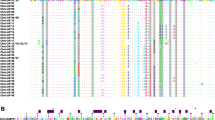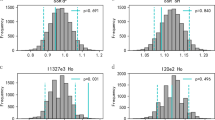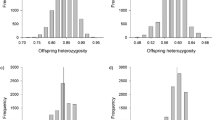Summary
Botryllus schlossen, a compound ascidian is found worldwide in temperate and subtropical shallow waters. This species, which originated in the Mediterranean Sea, has become cosmopolitan via the transportation of colonies attached to ship hulls. Two types of genetic markers (allorecognition alleles on the tunicate fusibility-histocompatibility locus and molecular markers, microsatellites) have been used here to characterize native populations of B. schlossen in the Istra Peninsula, Croatia (the Northern Adriatic Sea). In this area, ship transportation is locally restricted, reducing the possibility of gene flow from remote populations. Allorecognition assays revealed that fusion and rejection responses are similar to those recorded previously from other populations. Pairwise allorecognition assays performed on all combinations (n=120) from 16 colonies resulted in 14.9% rejections, due to the appearance of 10–19 calculated fusibility alleles, not equally frequent. Genetic diversity of two populations was tested by four polymorphic microsatellite loci (4–11 alleles). Hardy-Weinberg exact test for loci revealed a significant heterozygote deficiency, suggesting partial inbreeding. Comparisons with other populations worldwide further indicate the high polymorphism characteristic to this species.
Access this chapter
Tax calculation will be finalised at checkout
Purchases are for personal use only
Preview
Unable to display preview. Download preview PDF.
Similar content being viewed by others
References
Ben-Shlomo R, Douek J, Rinkevich B (2000) Heterozygote deficiency and chimerism in remote populations of a colonial ascidian from New Zealand. Mar Ecol Prog Ser 209:109–117
Berrill NJ (1950) The Tunicata. Ray Society, London
Boyd HC, Weissman I, Saito Y (1990) Morphologic and genetic verification that Monterey Botryllus and Woods Hole Botryllus are the same species. Biol Bull 178:239–250
Dybern IB (1969) Distribution and ecology of ascidians in Kviturdvikpollen and Vagsbopollen on the west coast of Norway. Sarsia 37:21–40
Graham DE (1978) The isolation of high molecular weight DNA from whole organisms or large tissue masses. Analytical Biochem 85:609–613
Grosberg RK (1991) Sperm-mediated gene flow and the genetic structure of a population of the colonial ascidian Botryllus schlossen. Evolution 45:130–142
Grosberg RK, Quinn JF (1986) The genetic control and consequences of kin recognition by the larvae of a colonial marine invertebrate. Nature 322:456–459
Kott P (1985) The Australian Ascidiacea. I. Phlebobranchia and Stolidobranchia. Mem Queensland Mus 23:1–440
Luckens PA (1976) Settlement and succession on rocky shores at Auckland, North Island, New Zealand. New Zealand Oceanogr Inst Mem 70
Müller WEG, Pancer Z, Rinkevich B (1994) Molecular cloning and localization of a novel serine protease from the colonial tunicate Botryllus schlossen. Mol Mar Biol Biotechnol 3:70–77
Oka H, Watanabe H (1960) Problems of colony specificity in compound ascidians. Bull Mar Biol Stn Asamushi 10:153–155
Pancer Z, Gershon H, Rinkevich B (1994) Direct typing of polymorphic microsatellites in the colonial tunicate Botryllus schlossert (Ascidiacea). Biochem Biophys Res Commun 203:646–651
Paz G (1999) Genetic variation among populations of a cosmopolitan urochordate along the Israeli coast. Israel J Zool 45:319
Plough HH (1978) Sea squirts of the Atlantic continental shelf from Maine to Texas. Johns Hopkins University Press, Baltimore, MD.
Raymond M, Rousset F (1995) GENEPOP (version 1.2): population genetics software for exact tests and ecumenicism. J Hered 86:248–249
Rinkevich B (1993) Immunological resorption in Botryllus schlossen (Tunicata) chimeras is characterized by multilevel hierarchial organization of histocompatibility alleles. A speculative endeavor. Biol Bull 184:342–345
Rinkevich B, Shapira M (1998) An improved diet for inland broodstock and the establishment of an inbred line from Botryllus schlössen, a colonial sea squirt (Ascidiacea). Aq Living Res 11:163–171
Rinkevich B, Weissman EL (1991) Interpopulational allogeneic reactions in the colonia protochordate Botryllus schlössen. Internat Immun 3:1265–1272
Rinkevich B, Porat R, Goren M (1995) Allorecognition elements on a urochordate histocompatibility locus indicate unprecedented extensive polymorphism. Proc R Soc Lond B 259:319–324
Rinkevich B, Porat R, Goren M (1998) Ecological and life history characteristics of Botryllus schlossen (Tunicata) populations inhabiting undersurface shallow water stones. PSZN Mar Ecol 19:129–145
Sabbadin A (1962) La basi genetiche delia capacita di fusione fra colonie in Botryllus schlossen (Ascidiancea). Rend Accad Lincei 32:1031–1035
Sabbadin A (1972) Results and perspectives in the study of a colonial ascidian, Botryllus schlossen. In: Battaglia B (ed) “5th European Marine Biology Symposium”. Piccin Editore, Padova, pp 327–334
Sabbadin A (1978) Genetics of the colonial ascidian, Botryllus schlossen. In: Battaglia B, Beardmore J (eds) Marine organisms. Plenum Press, New York, pp 195–209
Sabbadin A, Graziani G (1967) New data on the inheritance of pigments and pigmentation patterns in the colonial ascidian Botryllus schlossen (Pallas). Riv Biol 60:559–598
Scofield VL, Schlumpberger JM, West LA, Weissman IL (1982) Protochordate allorecognition is a controlled by an MHC-like gene system. Nature 295:499–502
Schneider S, Kueffer JM, Roessli D, Excoffier L (1997) ARLEQUIN, version 1.1: A software for population genetic data analysis. Genetics and Biometry Laboratory, University of Geneva, Switzerland
Skerman TM (1960) Ship-fouling in New Zealand waters: A survey of marine fouling organisms from vessels of the coastal and overseas trades. New Zealand J Sci 3:620–648
Stoner DS, Quattro JMQ, Weissman IL (1997) Highly polymorphic microsatellite loci in the colonial ascidian Botryllus schlossen. Mol Mar Biol Biotech 6:163–171
Tokioka T (1953) Ascidians of Sagami Bay, Iwanami-shoten, Tokyo
Yund PO, Marcum Y, Stewart-Savage J (1997) Life history variation in a colonial ascidian: broad-sense heritabilitis and tradeoffs in allocation to asexual growth and male and female reproduction. Biol Bull 192:290–299
Author information
Authors and Affiliations
Editor information
Editors and Affiliations
Rights and permissions
Copyright information
© 2001 Springer Japan
About this chapter
Cite this chapter
Rinkevich, B., Paz, G., Douek, J., Ben-Shlomo, R. (2001). Allorecognition and Microsatellite Allele Polymorphism of Botryllus schlosseri from the Adriatic Sea. In: Sawada, H., Yokosawa, H., Lambert, C.C. (eds) The Biology of Ascidians. Springer, Tokyo. https://doi.org/10.1007/978-4-431-66982-1_63
Download citation
DOI: https://doi.org/10.1007/978-4-431-66982-1_63
Publisher Name: Springer, Tokyo
Print ISBN: 978-4-431-66984-5
Online ISBN: 978-4-431-66982-1
eBook Packages: Springer Book Archive




